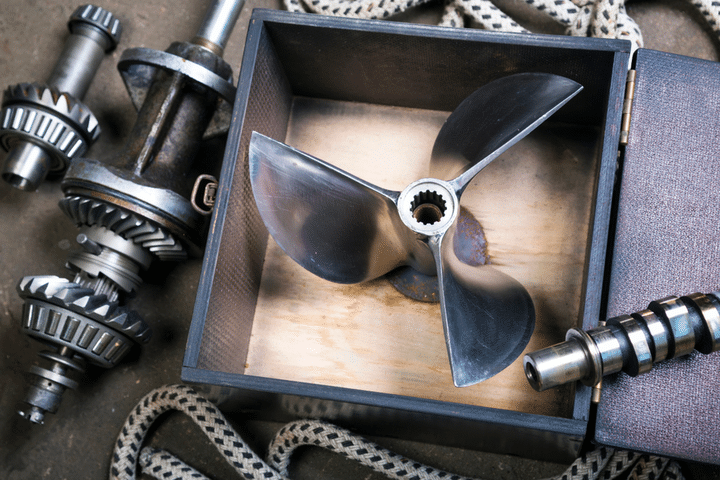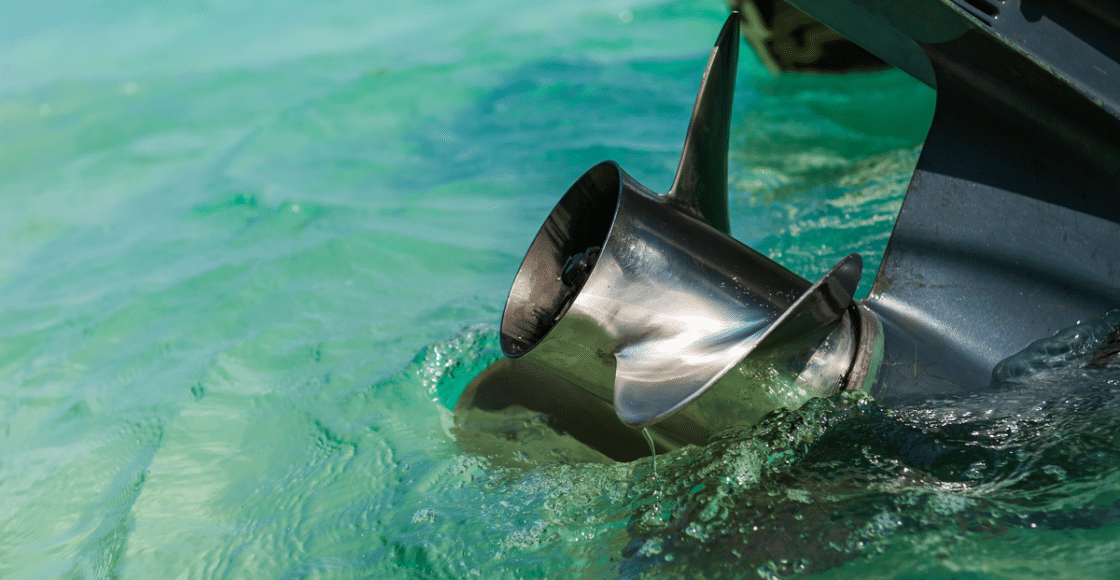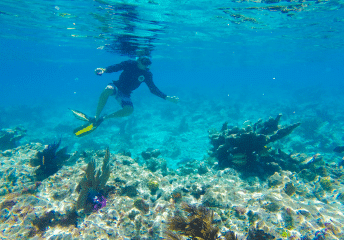21-pitch prop vs. 19-pitch prop
Last Updated on November 3, 2023 by Boatsetter Team
A propeller is a bit like a tire. It moves you forward, and you realize it until there’s a problem. It should be a part of your boat maintenance routine to check them. You may believe the motor should propel your boat faster than it does and wonder if changing the propellers will make a difference. Well, when you get one thing, you give up another. Often the trick is to take your time and get the right prop! Here, we’ll go over 21-pitch prop versus 19-pitch prop so you’ll know which prop is right for you and your boat.
Post summary:
- What is the difference between a 19-pitch and 21-pitch prop?
- What is a “prop pitch”?
- What pitch should my prop be?
- What is prop diameter?
- Is a 19-pitch prop faster?
- In what a direction does your propeller turn?
- How much does your new propeller cost?
- Need help paying off boat maintenance costs?
For this post, we want to get you started with a Pro tip:
A boat propeller has only two dimensions. Those are its diameter and pitch, and marine engine manufacturers recommend a particular propeller size for a specific size of the motor. The prop should maintain the engine’s optimum RPM at wide-open throttle (WOT).
List your boat for rent with Boatsetter. Earn an average of $20K annually!
What is the difference between a 19-pitch and 21-pitch prop?
When sizing propellers, you will need to know the pitch and diameter of the one you are replacing or upgrading to. So the two sizes you will need to know are the pitch of the blade and the diameter.
A simple explanation of prop pitch indicates that a 21-pitch prop if turning in a thick substance, will push your boat forward 21 inches for every revolution of the blades. Conversely, a 19-pitch propeller would move your boat forward 19 inches. However, some factors can affect this rate of distance. Water density and water motion can affect a boat’s forward motion. High winds, sailing into the tide, or both can affect a boat’s forward motion, especially small boats.
What is a “prop pitch”?
A prop pitch, or “propeller pitch,” is the distance a propeller would move forward with one full revolution if it were moving through a soft solid material. A soft solid is a substance that sometimes behaves as a solid and sometimes as a liquid. How a propeller moves through a soft solid is often likened to a screw penetrating a piece of wood, and propellers are often called screws.
Both water and mud have soft solid attributes. Along with salinity, air temperature, and other factors can affect their viscosity, affecting your speed. Yes, propellers are made specifically for mud, and pitch is a factor for them as it is an outboard engine built for offshore use in salty ocean water.
Altitude and the weight of your boat can also affect the performance of your prop and engine combination. Realize that pitch is not the only factor when seeking a propeller that keeps your motor revving in the acceptable range when at WOT. However, prop pitch is the most significant factor in how your boat and engine combination performs.
How the pitch of your prop affects your motor’s rpm
An engine with a WOT range of 5000 to 5800 rpm should optimally run at about 5400 rpm. If you increase the boat’s weight or decrease it, your engine will run at higher or lower revolutions due to the variance.
If your engine is running outside its WOT range when under load or loaded lightly, you may need to consider a new propeller. An engine operated outside of its optimal power range for an extended amount of time can cause damage. Some of which can be very costly.
There are a few variable-pitch propellers on the market. However, some boaters carry two sizes of props and change them due to weight loads, weather conditions, and how they will use their boat. Some propellers have a constant pitch, while others have a progressive pitch. This factor makes the propeller more efficient across a wider range of rpm and helps attain higher speeds.
What pitch should my prop be?
It depends on how you use your boat because a day of fishing and skiing has different requirements. For example, if you want a boat that will speed quickly because the bass won’t wait, you need a 21-pitch prop. However, if you want a powerful holeshot, choose the 19-pitch propeller blade.
As mentioned before, some boaters keep spare props to change them to suit the type of boating they will be doing, as well as for a spare. Taking a spare prop with you onboard is a good safe boating practice. Believe it or not, boats often get stranded and need Sea Tow because they have lost a propeller and can’t get back to shore.
What is prop diameter?

The measurement across a circle formed by the tips of the propeller’s blades is its diameter. This measurement is essential too, and in most circumstances, the larger the propeller, the slower your boat, as the lower the rpm’s, the larger the propeller.
Outboard and sterndrive manufacturers set these parameters for boats based on weight and desired top speed. The boat hull form also plays a role in how fast a boat will or will not go and how much power, combined with its propeller size, will be needed to keep your boat in its optimal rpm range at WOT.
Is a 19-pitch prop faster?
Yes, it is on the top end, but if you desire to come out of a hole shot quickly, then the 21-pitch prop is the better choice of the two. But, of course, that is if your engine will run within its optimal power band when so equipped.
READ MORE: What Is Boat Propeller Pitch?
In what direction does your propeller turn?
The size of your propeller is stamped on its hub, and a 14-inch diameter propeller with a pitch of 21 will read 14 x 21, indicating the diameter and then the pitch. Boats equipped with more than one outboard generally have counter-rotating propellers. The prop for each side will indicate L or R, whether it is a left or right-turning prop.
How much does a new propeller cost?

The cost of a new propeller depends on the material it is made from, its size, and even its form. For example, some propellers have fixed pitches, while others have a progressive pitch and others have variable pitch. The least expensive aluminum blade propellers cost less than $100, and 14 x 19 or 14 x 21 propellers can be purchased for less than $200.
Expect to double your costs if you get into progressive or variable pitch propellers or need props for two engines.
Do you need help paying for your boat maintenance?
As you know, if you own a boat, maintenance can be expensive. Then there are the extra expenses, like propellers and the other costs of owning a boat. However, this total can become a tidy sum, especially when it comes time for major repairs. For example, a missing-sized propeller can cause significant maintenance if your boat is not running in its optimal power range.
Renting your boat to those who live and visit your area can help you pay for those expenses, and a new propeller if you need one!
At Boatsetter, owners of boats across the world offer their boats for rent every day. From small fishing boats to yachts, captained and un-captained, boat owners have found that renting their boats helps offset some of their boating costs, and you can, too! So, give someone the opportunity to sail in your local waters with Boatsetter.
Check out the latest Boating accessories & gear or browse through our Boat Guides to find your next boating destination.
About us
Boatsetter is a unique boat-sharing platform that gives everyone — whether you own a boat or you’re just renting — the chance to experience life on the water. You can list a boat, book a boat, or make money as a captain.
List. Rent. Earn—Only at Boatsetter

Boatsetter empowers people to explore with confidence by showing them a world of possibility on the water. Rent a boat, list your boat, or become a Boatsetter captain today.










